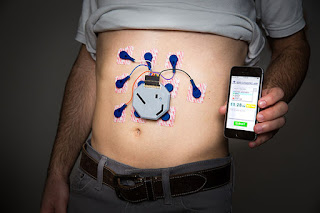Noninvasive Wearable System to Monitor Stomach Activity Throughout the Day as Holter ECG
prof .DRRAM,HIV /AIDS,HEPATITIS ,SEX DISEASES & WEAKNESS expert,New Delhi,India, profdrram@gmail.com,+917838059592,+919832025033,ON WHATSAPP
 A team of engineers and physicians has developed a wearable, non-invasive system to monitor electrical activity in the stomach over 24 hours—essentially an electrocardiogram but for the gastro-intestinal (GI) tract.The team tested the device, a 3D printed portable box connected to 10 small wearable electrodes, on 11 children and one adult volunteer. They found that data collected with the wearable system were comparable to data collected in the clinic with state-of-the-art methods, which are invasive--including a catheter inserted through the patient’s nose. They also found that the stomach’s electrical activity changes not only around meals, but also during sleep, following its own circadian rhythm.
A team of engineers and physicians has developed a wearable, non-invasive system to monitor electrical activity in the stomach over 24 hours—essentially an electrocardiogram but for the gastro-intestinal (GI) tract.The team tested the device, a 3D printed portable box connected to 10 small wearable electrodes, on 11 children and one adult volunteer. They found that data collected with the wearable system were comparable to data collected in the clinic with state-of-the-art methods, which are invasive--including a catheter inserted through the patient’s nose. They also found that the stomach’s electrical activity changes not only around meals, but also during sleep, following its own circadian rhythm.
“We think our system will spark a new kind of medicine, where a gastroenterologist can quickly see where and when a part of the GI tract is showing abnormal rhythms and as a result make more accurate, faster and personalized diagnoses,” said Armen Gharibans, the paper’s first author and a bioengineering postdoctoral researcher at the University of California San Diego.
“This work opens the door accurately monitoring the dynamic activity of the GI system,” he said. “Until now, it was quite challenging to accurately measure the electrical patterns of stomach activity in a continuous manner, outside of a clinical setting. From now on, we will be able to observe patterns and analyze them in both healthy and unwell people as they go about their daily lives.” “This will help us determine if the stomach is functioning properly during meals and - most importantly - when patients are experiencing symptoms such as nausea and belly pain,” said Dr. David Kunkel, one of the paper’s co-authors and a gastroenterologist at UC San Diego Health.
The researchers’ biggest challenge was designing algorithms that recognize and boost the stomach’s electrical signals amid noise and artifacts. This is especially difficult to do because the stomach’s electrical signals are 10 times weaker than the heart’s, making them harder to capture and analyze.
The device itself uses off-the-shelf electrodes used in electrocardiograms. The electronics and battery are encased in a 3D printed box and connected to the electrodes, which fit on a person’s abdomen just over the stomach.
The researchers worked with Dr. Hayat Mousa and tested the device on 11 pediatric patients at Rady Children’s Hospital in San Diego. These patients had been undergoing an invasive procedure called manometry, one of a couple clinical gold standards for objectively monitoring GI tract activity. The procedure requires using a catheter inserted through the nose to measure pressure at several points inside the stomach. Comparing the two methods showed that data collected by the wearable device was robust and reliable.
“I have been practicing pediatric gastroenterology and taking care of patients for 20 years," Dr. Mousa said. "The only method to assess gastrointestinal motility involves placing motility catheters in the GI tracts while kids are sedated or under general anesthesia. It has been a long journey discussing the benefits of doing such an invasive procedure with my patients and their families. My challenge has always been finding a test that offers a non-invasive assessment of the enteric nervous system and its connection with brain function."
"The technique outlined in this paper is the best way to evaluate children with motility and functional GI disorders," Dr. Mousa added. "It provides the information without need for sedation and it offers the flexibility to monitor kids while they continue their daily activities. The system is currently paired with a smart phone app that allows patients to log their meals, sleep and other activities. The long-term goal is to design an app that would allow patients and physicians to see the data collected by the device in real time.
- Kidney stones universally present hazard in north india,dillution by water prevent it
- Steroid and placebo effect equally for mild persisting asthma with low sputum eosinophils
- Government wants to fix public healthcare staff shortages with ayush docs: will it work?
- Plea in hc for payment of salaries of edmc, north mcd teachers and doctors
- 7 indian pharma companies named in us lawsuit over inflating generic drug prices
- Woman in up dies after explosion in her mouth during treatment,what is diagnosis?
- Woman in up dies after explosion in her mouth during treatment,what is diagnosis?
- Woman in up dies after explosion in her mouth during treatment,what is diagnosis?
- Air pollution ! mothers organising rally in london,anaesthetist choosing gas,will india follow?
- Cardiac arrest is always not sudden as understood -a study

 Comments (
Comments ( Category (
Category ( Views (
Views (